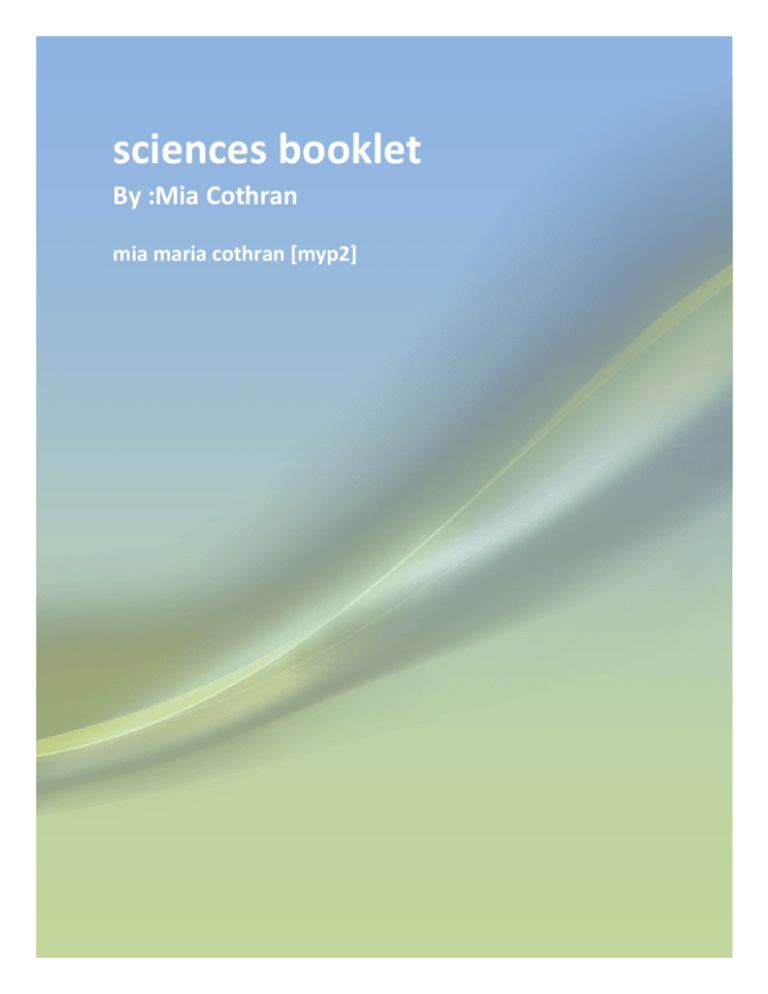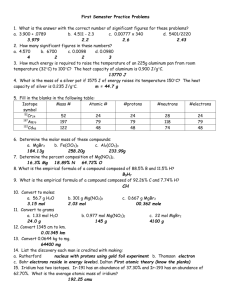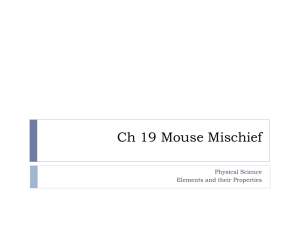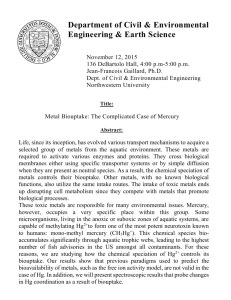sciences booklet - mia
advertisement

sciences booklet
By :Mia Cothran
mia maria cothran [myp2]
TABLE OF CONTENTS
Pg 1: reactions of metals {reactive
&least reactive}
Pg2 : reactions with oxygen
etc..
Pg3: periodic table & 6 noble
gases!
Pg4 :continued…….
Pg5 : Alkali metals and
transition metals!
Pg 6: molecules and the
different types!
Pg7: quiz
Pg8 : fun word search
Reactions of Metals
some metals are very un-reactive.
That means they do not easily take
part in chemical reactions . For
example platinum does not react with
the oxygen in the air, even if it is heated by a Bunsen burner flame.
On the other hand some metals are very reactive and they easily take
part In chemical reactions to make new substances. Magnesium
when heated lets of s brilliant white flame!
Putting chemicals in order of reactivity
When putting the metals in order of reactivity it
is called a reactivity series. If you want to
learn the reactivity series, you could try
making up a mnemonic or silly sentence to
help. Here's one - can you do better?
"Pond slime can make a zoo interesting the long crinkly sort goes purple."
Reactions with oxygen
remember that metals react with oxygen in the air to produce metal
oxides. This is an example of two non-metals
Reactions on next page
“sulphur &carbon”
carbon burns in the air to form carbon dioxide.
carbon + oxygen= carbon dioxide
sulphur + oxygen = sulphur dioxide
Non-metal oxides such as Sulphur
dioxide and nitrogen dioxide are actually what create acid rain. They
dissolve in the water in the clouds to form acidic solutions. Acid
rain damages rocks and buildings, and harms wildlife.
The differences between metal oxides and non-metal oxides
there are some important differences between the physical and
chemical properties of metal oxides and non-metal oxides the table
below shows how you distinguish them.
non –metal oxides
Usually gases at room
Metal oxides
Solids at room temperature
temp.
Bases- if they dissolve they
form alkaline solutions
Dissolve in water to form acidic
solutions
Periodic table
PERIODIC TABLE ON NEXT PAGE
There are more than 100
elements. The periodic
table is basically a chart
showing all the elements
their proper category.
periodic sub-divisions are Alkali metals , halogens, transitions
Note : you will never find a compound in
the periodic table because it consists of
two or more elements joined together!
in
The
metals and noble gases. The periodic table has eight main groups.
For example, group 1 contains very reactive metals such as sodium Na - while group 7 contains very reactive non-metals such as chlorine
- Cl.
The six noble gases
Why are they called the 6 noble gases?
Noble gas" is the translation of the German Edelgas, which was in use as
early as 1898. The noble gases have also been referred to as inert gases,
but this term is not strictly accurate because several of them do take part in
chemical reactions.
The six noble gases are found in group 18 of the periodic table. They
go in order of increasing weight. These elements were considered to
be inert gases , as they have a closed-shell configuration. Until the
1960’s their oxidation number of 0 prevents the
noble gases from forming compounds readily.
-helium
argon
-krypton
6 noble gases on next page
⌘
-xenon
And radon
-
Who’s in the Family?
All of the elements in Group Zero
are inert gases. The list is Helium
(He), Neon (Ne), Argon (Ar),
Krypton (Kr), Xenon (Xe), and
Radon (Rn). Don't think that
because these elements don't
react, we don't use them. You will find inert gases all over
our world. Neon is used in advertising signs Argon is used
in light bulbs. Helium is used to cool
things and in balloons. Xenon is used in
headlights for new cars. When you move
down the periodic table, as the atomic
numbers increase, the elements become
more and more rare.
Alkali Metals
Alkali and transition metals on next page
Alkali metals are found in group one
of the periodic table, they are very reactive metals that do not occur
freely in nature. These metals have only 1 electron in their outer shell.
Alkali metals are good for conducting heat and electricity.
The alkali metals are: lithium , sodium , potassium , rubidium , cesium
& francium!
Transition Metals
The 38 elements in group 3 through 12 of the periodic table are called
“transition metals”. As with all metals , the transition elements are
both ductile and malleable. The interesting thing about transition
metals is that because their valence electrons, or the electrons they
use to combine with other elements, are present in more than one
shell. And this is what creates the BIG spark! Some transition metals
are : Scandium , titanium , iron , vanadium , cobalt and any more!
Molecules
Molecules on next page
What are molecules?
A molecule is a group of two or more atoms
that stick together. Molecules { moll-uhcyools} are so small that nobody can see
them , except for an electron microscope. pretty much everything on
earth and on other planets are made up of molecules and so is some
of the dust in space! The first molecules formed about 3000,000
years after the BIG BANG, 0r just under 15 billion years ago they
were the smallest kind of molecule-two hydrogen atom joined
together!
The different types of molecules
some common types of molecules are : acetone , acetic acid ,
adenine , a dipic acid and many more!
LETS see if you were really taking in the knowledge! If you can answer the following
questions you are a true SCIENTIST! Have fun and try your best!
Puzzles , games and fun! on next page!
Question 1:what are molecules?
Question 2: name one alkali metal!
Question 3: name all 6 noble gases!
Question 4: what group are transition metals in?
Question 5 :No peaking! what is the sign for Radon?
IF YOU
ANSWE
RED
ALL OF
THE FOLLOWING CORRECTLY YOU ARE A
TRUE SCIENTIST!
5
SUBMIT YOUR SCORE
OUT OF 5!
http://www.google.com/search?client=safari&rls=e
n&q=science+pics&ie=UTF-8&oe=UTF-8
http://www.historyforkids.org/scienceforkids/chemistry/atoms/molecul
es.htm
http://www.google.com/search?client=safari&rls=en&q=iron+explodin
g&oe=UTF-8&um=1&ie=UTF8&hl=en&tbm=isch&source=og&sa=N&tab=wi&ei=d4kYT8eRItK60A
G9hPXNCw
http://www.chem4kids.com/files/elem_inertgas.html
http://www.google.com/search?client=safari&rls=en&q=gases+in+the
+periodic+table&ie=UTF-8&oe=UTF-8
http://answers.yahoo.com/question/index?qid=20070801165438AAIr
GMa
http://www.bbc.co.uk/schools/gcsebitesize/science/aqa_pre_2011/roc
ks/atomsrev3.shtml
http://www.bbc.co.uk/schools/ks3bitesize/science/chemical_material_
behaviour/compounds_mixtures/revise6.shtml
http://www.s-cool.co.uk/gcse/chemistry/metals-the-reactivityseries/revise-it/reactions-of-metals
http://www.google.com/search?client=safari&rls=en&q=acid+rain&oe
=UTF-8&um=1&ie=UTF8&hl=en&tbm=isch&source=og&sa=N&tab=wi&ei=3lcYT7SeMeWU0
QGAw_3RCw
molecules, chemistry, periodic, sciences, alkali, metals, gases,
table, atoms, noble, gases, radon, acid, rain, neon,
Un-crack the words
Leculesmos :
Omtas
Talsme
Idca
Ianr
Erpdicoi








